Spatial Distribution of Precise Suitability of Plantation: A Case Study of Main Coniferous Forests in Hubei Province, China
Abstract
:1. Introduction
2. Materials and Methods
2.1. Study Area
2.2. Data and Method
2.2.1. Data Acquisition
2.2.2. Data Processing
2.3. Ecological Function Evaluation of the Sample Land
2.4. Space Suitability Division
2.4.1. Space Suitable for Unit Screening
2.4.2. Filtering of Potential Distribution Key Environment Variables
2.4.3. MaxEnt Model
2.5. Validation of Model Accuracy
3. Results
3.1. Spatial Distribution of Main Coniferous Forests
3.2. Evolution Characteristics of Landscape Patterns of LUCC
3.3. Accuracy Verification of Species Distribution Model Simulation Results
3.4. Spatial Distribution and Quantitative Structure of Eco-Environment
4. Discussion
4.1. Spatial Distribution of Suitable Growing Area of Coniferous Forests
4.2. Other Factors That Influence Model Simulation
4.3. Afforestation and Other Measures for Sustainable Management
5. Conclusions
Author Contributions
Funding
Data Availability Statement
Conflicts of Interest
Appendix A
| Evaluation Factors | Classification Criteria | Weight | ||
|---|---|---|---|---|
| Ⅰ | Ⅱ | Ⅲ | ||
| Forest Stock | ≥150 (m3/ha) | 50~150(m3/ha) | <50(m3/ha) | 0.20 |
| Forest Naturalness | Ⅰ, Ⅱ | Ⅲ, Ⅳ | Ⅴ | 0.15 |
| Community structure | Complete structure | More complete structure | Simple structure, | 0.15 |
| Stand structure | Thermal coniferous forest; Thermal coniferous broad-leaved mixed forest | Warm coniferous broad-leaved mixed forest; Warm coniferous forest; Warm mixed broad-leaved conifer forest | Cold and temperate coniferous forests; Temperate coniferous forests | 0.15 |
| Stand average height | ≥15.0 m | 5.0~14.9 m | <5.0 m | 0.10 |
| Crown density | ≥0.7 | 0.40~0.69 | 0.20~0.39 | 0.10 |
| Vegetation coverage | ≥70% | 50~69% | <50% | 0.10 |
| Thickness of dead leaves | ≥10 cm | 5~9 cm | <5 cm | 0.05 |
| Functional Level | Forest Ecological Function Index |
|---|---|
| I | ≥0.67 |
| II | 0.67~0.42 |
| III | <0.42 |
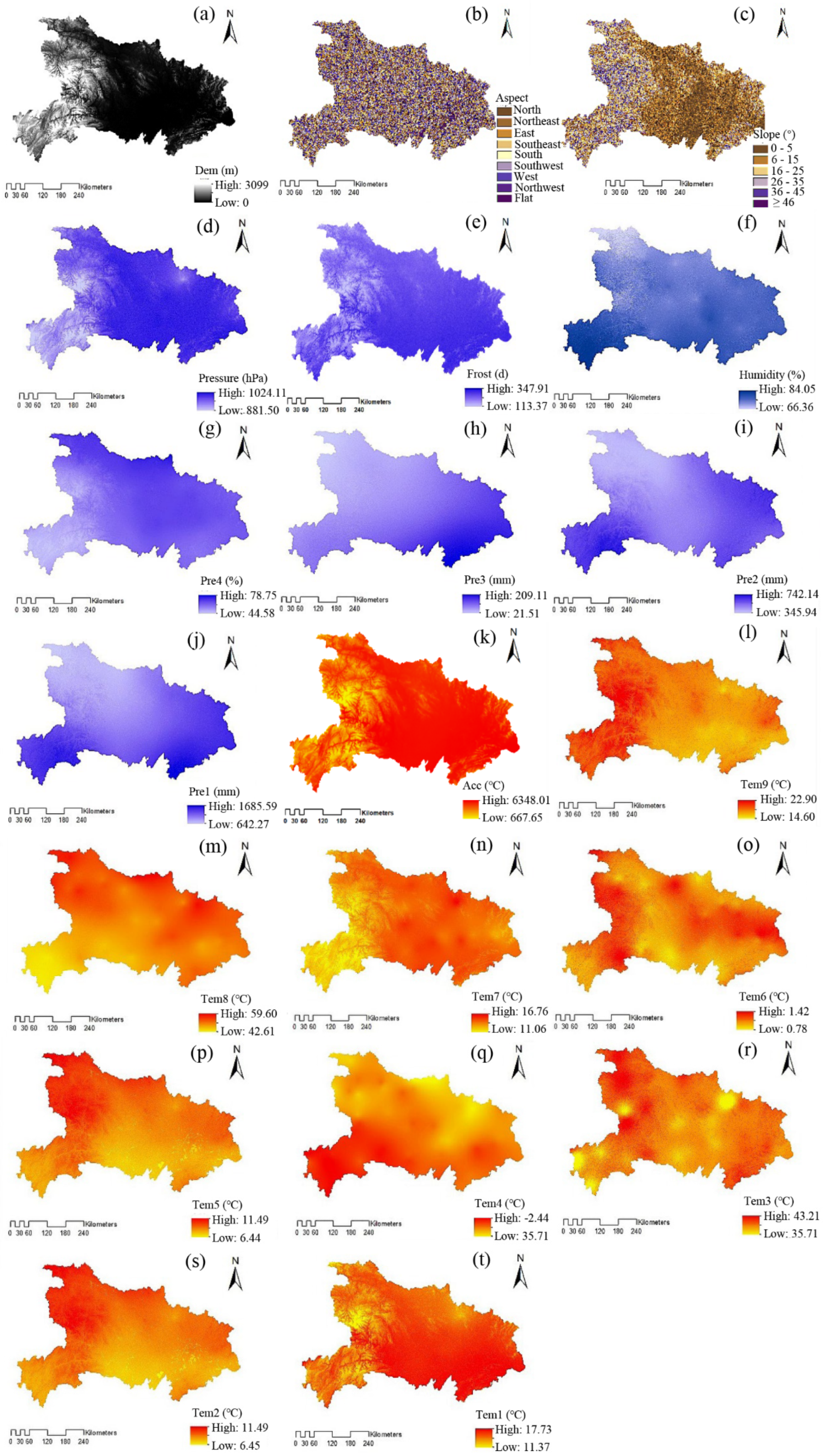
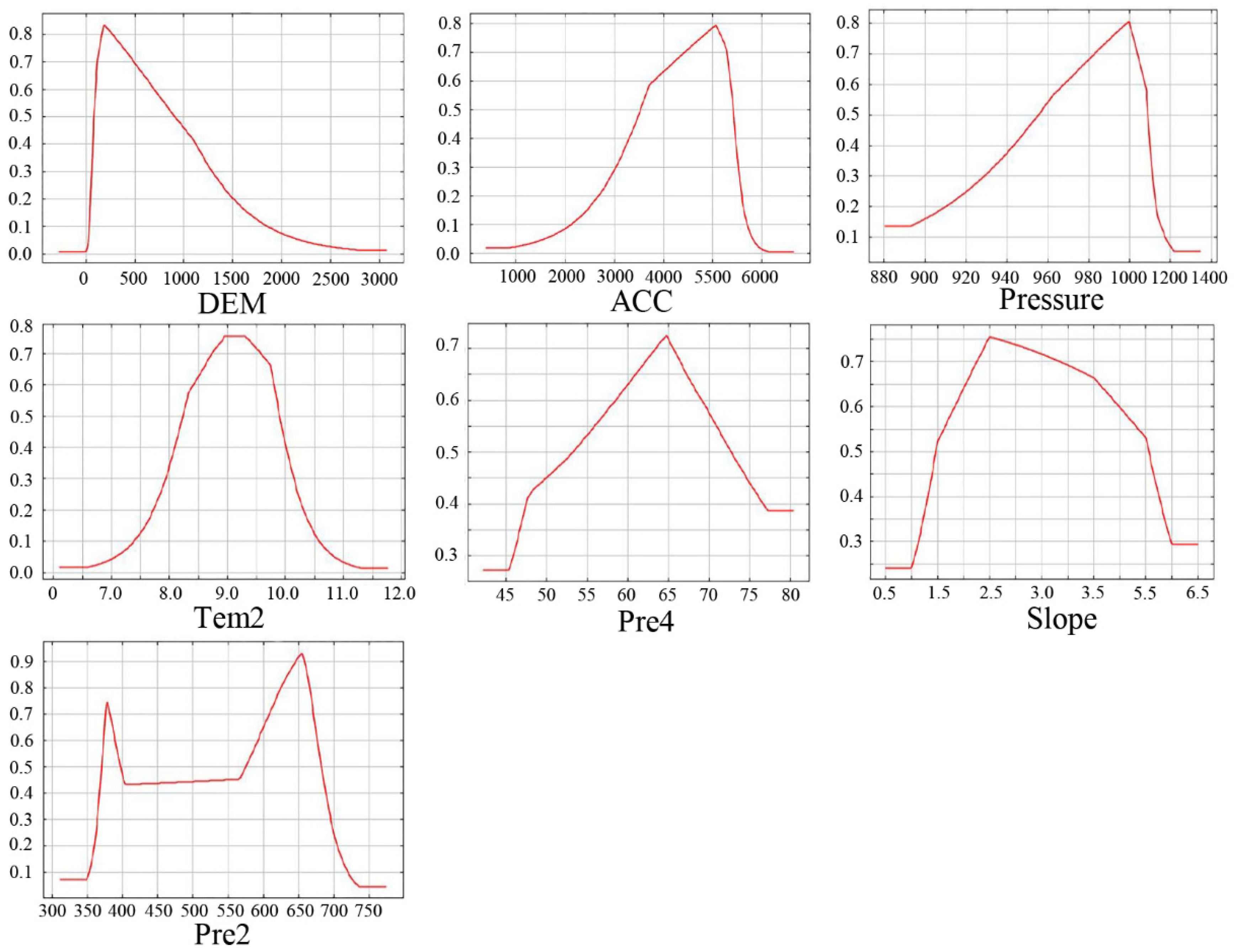


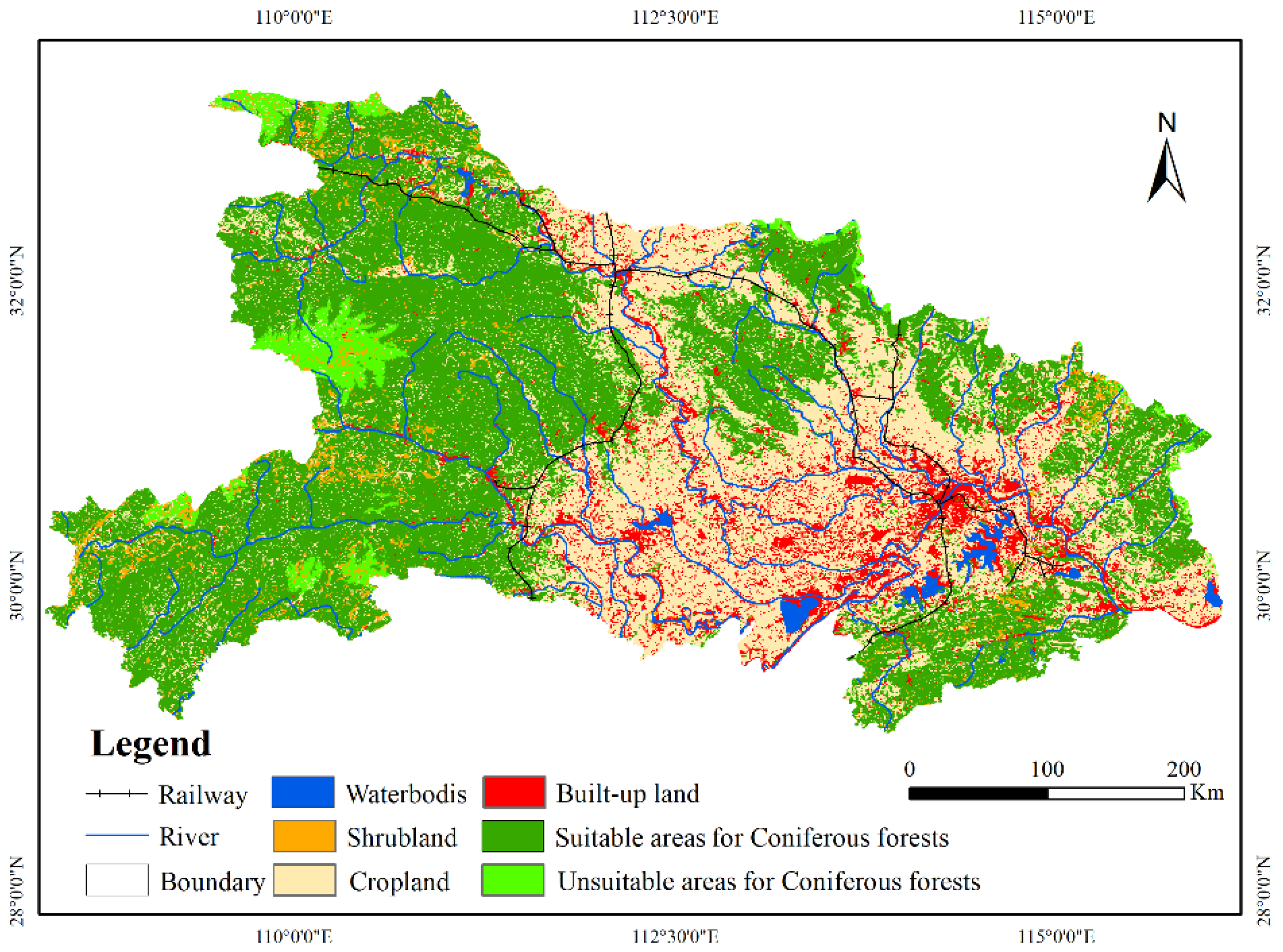
References
- Malkamäki, A.; D’Amato, D.; Hogarth, N.J.; Kanninen, M.; Pirard, R.; Toppinen, A.; Zhou, W. A systematic review of the socio-economic impacts of large-scale tree plantations, worldwide. Glob. Environ. Chang. 2018, 53, 90–103. [Google Scholar] [CrossRef]
- Afonso, R.; Miller, D.C. Forest plantations and local economic development: Evidence from Minas Gerais, Brazil. For. Policy Econ. 2021, 133, 102618. [Google Scholar] [CrossRef]
- Zeng, Y.L.; Wu, H.S.; Ouyang, S.; Liang, C.; Fang, X.; Peng, C.H.; Liu, S.R.; Xiao, W.F.; Xiang, W.H. Ecosystem service multifunctionality of Chinese fir plantations differing in stand age and implications for sustainable management. Sci. Total Environ. 2021, 788, 14779. [Google Scholar] [CrossRef] [PubMed]
- Bayat, F.; Monfared, A.B.; Jahansooz, M.R.; Esparza, E.T.; Keshavarzi, A.; Morera, A.G.; Fernández, M.P.; Cerdà, A. Analyzing long-term soil erosion in a ridge-shaped persimmon plantation in eastern Spain by means of ISUM measurements. Catena 2019, 183, 104176. [Google Scholar] [CrossRef]
- Yamagishi, K.; Kizaki, K.; Shinohara, Y.; Hirata, R.; Ito, S. Effects of weeding the shrub layer during thinning on suface soil erosion in a hinoki plantation. Catena 2022, 209, 105799. [Google Scholar] [CrossRef]
- Cai, W.; Yang, C.; Wang, X.; Wu, C.; Larrieu, L.; Lopez-Vaamonde, C.; Wen, Q.; Yu, D.W. The ecological impact of pest-induced tree dieback on insect biodiversity in Yunnan pine plantations, China. For. Ecol. Manag. 2021, 491, 119173. [Google Scholar] [CrossRef]
- Xi, B.; Clothier, B.; Coleman, M.; Duan, J.; Hu, W.; Li, D.; Di, N.; Liu, Y.; Fu, J.; Li, J.; et al. Irrigation management in poplar (Populus spp.) plantations: A review. For. Ecol. Manag. 2021, 494, 119330. [Google Scholar] [CrossRef]
- Monsef, A.H.; Hassan, M.A.A.; Shata, S. Using spatial data analysis for delineating existing mangroves stands and siting suitable locations for mangroves plantation. Comput. Electron. Agric. 2017, 141, 310–326. [Google Scholar] [CrossRef]
- Wang, Q. Experience of foreign plantation construction. Agric. World 1992, 8, 42–44. (In Chinese) [Google Scholar]
- Food and Agriculture Organization of the United Nations, FAO. Available online: https://fra-data.fao.org/WO/fra2020/home/ (accessed on 5 April 2022).
- Yi, Y.; Wang, B.; Shi, M.C.; Meng, Z.K.; Zhang, C. Variation in Vegetation and Its Driving Force in the Middle Reaches of the Yangtze River in China. Water 2021, 13, 2036. [Google Scholar] [CrossRef]
- Souliyavongsa, X.; Pierret, A.; Trelo-ges, V.; Ayutthaya, S.I.N.; Sayavong, S.; Hartmann, C. Does forest conversion to tree plantations affect properties of subsoil horizons? Findings from mainland Southeast Asia (Lao PDR, Yunnan-China). Geoderma Reg. 2022, 28, e00457. [Google Scholar] [CrossRef]
- Ma, Q.Q.; Huang, B.L. Advance in research on site productivity decline of timber plantations. J. Nanjing For. Univ. 1997, 2, 79–84. (In Chinese) [Google Scholar]
- Zhao, G.; Dong, J.; Cui, Y.; Liu, J.; Zhai, J.; He, T.; Zhou, Y.; Xiao, X. Evapotranspiration-dominated biogeophysical warming effect of urbanization in the Beijing-Tianjin-Hebei region, China. Clim. Dyn. 2019, 52, 1231–1245. [Google Scholar] [CrossRef]
- Tian, Y.; Zeng, C.H.; Li, Z.Q.; Zhang, H.L. Evaluation of Marine Ecological Suitability for Development and Utilization of Offshore Areas in Qingdao. J. Guangdong Ocean Univ. 2021, 41, 17–22. [Google Scholar]
- Luo, Z.; Asproudi, C. Subsurface urban heat island and its effects on horizontal ground-source heat pump potential under climate change. Appl. Therm. Eng. 2015, 90, 530–537. [Google Scholar] [CrossRef]
- Zhao, Y.; Deng, X.; Xiang, W.; Chen, L.; Ouyang, S. Predicting potential suitable habitats of Chinese fir under current and future climatic scenarios based on Maxent model. Ecol. Inform. 2021, 64, 101393. [Google Scholar] [CrossRef]
- Qin, A.; Liu, B.; Guo, Q.; Bussmann, R.W.; Ma, F.; Jian, Z.; Xu, G.; Pei, S. Maxent modeling for predicting impacts of climate change on the potential distribution of Thuja sutchuenensis Franch., an extremely endangered conifer from southwestern China. Glob. Ecol. Conserv. 2017, 10, 139–146. [Google Scholar] [CrossRef]
- Liu, Y.; Huang, P.; Lin, F.; Yang, W.; Gaisberger, H.; Christopher, K.; Zheng, Y. MaxEnt modelling for predicting the potential distribution of a near threatened rosewood species (Dalbergia cultrata Graham ex Benth). Ecol. Eng. 2019, 141, 105612. [Google Scholar] [CrossRef]
- Sheng, W.; Zhen, L.; Xie, G.; Xiao, Y. Determining eco-compensation standards based on the ecosystem services value of the mountain ecological forests in Beijing, China. Ecosyst. Serv. 2017, 26, 422–430. [Google Scholar] [CrossRef]
- Pecchi, M.; Marchi, M.; Burton, V.; Giannetti, F.; Morondo, M.; Bernetti, L.; Bindi, M.; Chirici, G. Species distribution modelling to support forest management. A literature review. Ecol. Model. 2019, 411, 108817. [Google Scholar] [CrossRef]
- Silva, L.D.; Elias, R.B.; Silva, L. Modelling invasive alien plant distribution: A literature review of concepts and bibliometric analysis. Environ. Model. Softw. 2021, 145, 105203. [Google Scholar] [CrossRef]
- Wong, M.H.G.; Li, R.Q.; Xu, M.; Long, Y.C. An integrative approach to assessing the potential impacts of climate change on the Yunnan snub-nosed monkey. Biol. Conserv. 2013, 158, 401–409. [Google Scholar] [CrossRef]
- Zhang, M.-G.; Slik, J.W.F.; Ma, K.-P. Using species distribution modeling to delineate the botanical richness patterns and phytogeographical regions of China. Sci. Rep. 2016, 6, 22400. [Google Scholar] [CrossRef] [PubMed] [Green Version]
- Peterson, A.T.; Vieglais, D.A. Predicting species invasions using ecological niche modeling: New approaches from bioinformatics attack a pressing problem. Bioscience 2001, 51, 363–371. [Google Scholar] [CrossRef]
- Ganeshaiah, K.N.; Barve, N.; Nath, N.; Chandrashekara, K.; Swamy, M.; Uma Shaanker, R. Predicting the potential geographical distribution of the sugarcane woolly aphid using GARP and DIVA-GIS. Curr. Sci. 2003, 85, 1526–1528. [Google Scholar]
- Cabeza, M.; Araujo, M.B.; Wilson, R.J.; Thomas, C.D.; Cowley, M.J.R.; Moilanen, A. Combining probabilities of occurrence with spatial reserve design. J. Appl. Ecol. 2004, 41, 252–262. [Google Scholar] [CrossRef]
- Sarma, R.; Munsi, M.; Neelavara Ananthram, A. Effect of Climate Change on Invasion Risk of Giant African Snail (Achatina fulica Férussac, 1821: Achatinidae) in India. PLoS ONE 2015, 10, e0143724. [Google Scholar] [CrossRef] [Green Version]
- Adams-Hosking, C.; McAlpine, C.A.; Rhodes, J.R.; Moss, P.T.; Grantham, H.S. Prioritizing Regions to Conserve a Specialist Folivore: Considering Probability of Occurrence, Food Resources, and Climate Change. Conserv. Lett. 2015, 8, 162–170. [Google Scholar] [CrossRef] [Green Version]
- Li, G.; Xu, G.; Guo, K.; Du, S. Geographical boundary and climatic analysis of Pinus tabulaeformis in China: Insights on its afforestation. Ecol. Eng. 2016, 86, 75–84. [Google Scholar] [CrossRef]
- Remya, K.; Ramachandran, A.; Jayakumar, S. Predicting the current and future suitable habitat distribution of Myristica dactyloides Gaertn. using MaxEnt model in the Eastern Ghats, India. Ecol. Eng. 2015, 82, 184–188. [Google Scholar] [CrossRef]
- Kozhoridze, G.; Orlovsky, N.; Orlovsky, L.; Blumberg, D.G.; Golan-Goldhirsh, A. Geographic distribution and migration pathways of Pistacia—Present, past and future. Ecography 2015, 38, 1141–1154. [Google Scholar] [CrossRef]
- Schroth, G.; Läderach, P.; Martinez-Valle, A.I.; Bunn, C.; Jassogne, L. Vulnerability to climate change of cocoa in West Africa: Patterns, opportunities and limits to adaptation. Sci. Total Environ. 2016, 556, 231–241. [Google Scholar] [CrossRef] [PubMed] [Green Version]
- Nix, H.; MacMahon, J.; Mackenzie, D. Potential areas of production and the future pigeon pea and other grain legumes in Australia. In The Potential for Pigeon Pea in Australia, Proceedings of Pigeon Pea (Cajanus cajan (L.) Millsp.) Field Day, Queensland, Australia, 29 April 1977; Wallis, E.S., Whiteman, P.C., Eds.; University of Queensland: Brisbane, QLD, Australia, 1977; pp. 1–12. [Google Scholar]
- Walker, P.A.; Cocks, K.D. HABITAT: A Procedure for Modelling a Disjoint Environmental Envelope for a Plant or Animal Species. Glob. Ecol. Biogeogr. Lett. 1991, 1, 108. [Google Scholar] [CrossRef]
- Kells, N.J. Review: The Five Domains model and promoting positive welfare in pigs. Animal 2021, 100378. [Google Scholar] [CrossRef]
- Darabi, H.; Choubin, B.; Rahmati, O.; Torabi Haghighi, A.; Pradhan, B.; Kløve, B. Urban flood risk mapping using the GARP and QUEST models: A comparative study of machine learning techniques. J. Hydrol. 2019, 569, 142–154. [Google Scholar] [CrossRef]
- Ray, A.; Halder, T.; Jena, S.; Sahoo, A.; Ghosh, B.; Mohanty, S.; Mahapatra, N.; Nayak, S. Application of artificial neural network (ANN) model for prediction and optimization of coronarin D content in Hedychium coronarium. Ind. Crops Prod. 2020, 146, 112186. [Google Scholar] [CrossRef]
- Xu, A.; Li, R.; Chang, H.; Xu, Y.; Li, X.; Lin, G.; Zhao, Y. Artificial neural network (ANN) modeling for the prediction of odor emission rates from landfill working surface. Waste Manag. 2022, 138, 158–171. [Google Scholar] [CrossRef]
- Kaky, E.; Nolan, V.; Alatawi, A.; Gilbert, F. A comparison between Ensemble and MaxEnt species distribution modelling approaches for conservation: A case study with Egyptian medicinal plants. Ecol. Inform. 2020, 60, 101150. [Google Scholar] [CrossRef]
- West, A.; Kumar, S.; Brown, C.; Stohlgren, T.; Bromberg, J. Field validation of an invasive species Maxent model. Ecol. Indic. 2016, 36, 126–134. [Google Scholar] [CrossRef] [Green Version]
- He, P.; Li, J.; Li, Y.; Xu, N.; Gao, Y.; Guo, L.; Huo, T.; Peng, C.; Meng, F. Habitat protection and planning for three Ephedra using the MaxEnt and Marxan models. Ecol. Indic. 2021, 133, 108399. [Google Scholar] [CrossRef]
- Bi, Y.Q.; Zhang, M.X.; Chen, Y.; Wang, A.X.; Li, H.H. Suitable habitat distribution of Paeonia lactiflora in China based on Biomod2 combination model. China J. Chin. Mater. Med. 2022, 47, 376–384. (In Chinese) [Google Scholar] [CrossRef]
- Osawa, T.; Mitsuhashi, H.; Uematsu, Y.; Ushimaru, A. Bagging GLM: Improved generalized linear model for the analysis of zero-inflated data. Ecol. Inform. 2011, 6, 270–275. [Google Scholar] [CrossRef]
- da Silva Marques, D.; Costa, P.G.; Souza, G.M.; Cardozo, J.G.; Barcarolli, I.F.; Bianchini, A. Selection of biochemical and physiological parameters in the croaker Micropogonias furnieri as biomarkers of chemical contamination in estuaries using a generalized additive model (GAM). Sci. Total Environ. 2019, 647, 1456–1467. [Google Scholar] [CrossRef] [PubMed]
- Liu, J.; Zhang, L.; Zhang, Q.; Zhang, G.; Teng, J. Predicting the surface urban heat island intensity of future urban green space development using a multi-scenario simulation. Sustain. Cities Soc. 2021, 66, 102698. [Google Scholar] [CrossRef]
- Jaroenkietkajorn, U.; Gheewala, S.H. Land suitability assessment for oil palm plantations in Thailand. Sustain. Prod. Consum. 2021, 28, 1104–1113. [Google Scholar] [CrossRef]
- Kabir, M.; Webb, E. Productivity and suitability analysis of social forestry woodlot species in Dhaka Forest Division, Bangladesh. For. Ecol. Manag. 2005, 212, 243–252. [Google Scholar] [CrossRef]
- Kimsey, M.J., Jr.; Moore, J.; Mcdaniel, P. A Geographically Weighted Regression Analysis of Douglas-Fir Site Index in North Central Idaho. For. Sci. 2008, 54, 356–366. [Google Scholar]
- Wang, S.F.; Chen, Y.K.; Cheng, C.C. Application of Ecosystem Management Decision Support System in selecting suitable site for Taiwan. Suitabil. Assess. Land Resour. 2002, 66, 1670–1678. [Google Scholar]
- Yi, Y.; Cheng, X.; Yang, Z.; Zhang, S. Maxent modeling for predicting the potential distribution of endangered medicinal plant (H. riparia Lour) in Yunnan, China. Ecol. Eng. 2016, 92, 260–269. [Google Scholar] [CrossRef]
- Li, L.; Zha, Y.; Zhang, J. Spatially non-stationary effect of underlying driving factors on surface urban heat islands in global major cities. Int. J. Appl. Earth Obs. Geoinf. 2020, 90, 102131. [Google Scholar] [CrossRef]
- Li, B.; Wang, W.; Bai, L.; Wang, W.; Chen, N. Effects of spatio-temporal landscape patterns on land surface temperature: A case study of Xi’an city, China. Environ. Monit. Assess. 2018, 190, 419. [Google Scholar] [CrossRef] [PubMed]
- He, Q.; Zeng, C.; Xie, P.; Liu, Y.; Zhang, M. An assessment of forest biomass carbon storage and ecological compensation based on surface area: A case study of Hubei Province, China. Ecol. Indic. 2018, 90, 392–400. [Google Scholar] [CrossRef]
- Jin, J.; Wang, R.S.; Li, F.; Huang, J.L.; Zhou, C.B.; Zhang, H.T.; Yang, W.R. Conjugate ecological restoration approach with a case study in Mentougou district, Beijing. Ecol. Complex. 2011, 8, 161–170. [Google Scholar] [CrossRef]
- State Forestry Administration of China. Technical Provisions for Continuous Inventory of State Forest Resources. 2014. Available online: https://www.doc88.com/p-6071845802352.html (accessed on 5 April 2022).
- Guo, L.; Liu, R.; Men, C.; Wang, Q.; Miao, Y.; Zhang, Y. Quantifying and simulating landscape composition and pattern impacts on land surface temperature: A decadal study of the rapidly urbanizing city of Beijing, China. Sci. Total Environ. 2019, 654, 430–440. [Google Scholar] [CrossRef] [PubMed]
- Zhang, S.; Liu, X.; Li, R.; Wang, X.; Cheng, J.; Yang, Q.; Kong, H. AHP-GIS and MaxEnt for delineation of potential distribution of Arabica coffee plantation under future climate in Yunnan, China. Ecol. Indic. 2021, 132, 108339. [Google Scholar] [CrossRef]
- Phillips, S.J.; Dudík, M.; Schapire, R.E. A maximum entropy approach to species distribution modeling. In Proceedings of the 21st International Conference on Machine Learning—ICML ’04, New York, NY, USA, 4 July 2004; p. 83. [Google Scholar]
- Yuan, H.; Liu, B.; Chen, S.G.; Zhu, J.; Liu, Y.; Xu, Y.Z. Study on the growth regularity of high density Chinese fir plantation in Hubei province. Hubei For. Sci. Technol. 2021, 50, 17. (In Chinese) [Google Scholar]
- Mu, X.Y.; Wu, Z.Y.; Li, X.Y.; Wang, F.; Bai, X.X.; Guo, S.W.; Cheng, R.C.; Yu, S.L. Estimation of the potential distribution areas of Larix principis—Rupprechtii plantation in Chifeng based on MaxEnt model. J. Arid. Land Resour. Environ. 2021, 35, 144–152. (In Chinese) [Google Scholar] [CrossRef]
- Jayasinghe, S.L.; Kumar, L. Modeling the climate suitability of tea [Camellia sinensis (L.) O. Kuntze] in Sri Lanka in response to current and future climate change scenarios. Agric. For. Meteorol. 2019, 272–273, 102–117. [Google Scholar] [CrossRef]
- Yi, Y.; Zhang, C.; Zhang, G.L.; Xing, L.Q.; Zhong, Q.C.; Liu, J.L.; Lin, Y.C.; Zheng, X.W.; Yang, N.; Sun, H.; et al. Effects of Urbanization on Landscape Patterns in the Middle Reaches of the Yangtze River Region. Land 2021, 10, 1025. [Google Scholar] [CrossRef]
- State Forestry Administration of Hubei Province, China. Policy interpretation of Hubei Province Forestry Development “Fourteenth Five-Year Plan”. 2021. Available online: https://lyj.hubei.gov.cn/zfxxgk/zc_GK2020/zcjd_GK2020/202201/t20220107_3956172.shtml (accessed on 5 April 2022).
- Wang, R.; Cai, M.; Ren, C.; Bechtel, B.; Xu, Y.; Ng, E. Detecting multi-temporal land cover change and land surface temperature in Pearl River Delta by adopting local climate zone. Urban Clim. 2019, 28, 100455. [Google Scholar] [CrossRef]
- Ke, Q.; Zhang, K. Patterns of runoff and erosion on bare slopes in different climate zones. Catena 2021, 198, 105069. [Google Scholar] [CrossRef]
- Wu, J.; Liu, C.; Wang, H. Analysis of Spatio-temporal patterns and related factors of thermal comfort in subtropical coastal cities based on local climate zones. Build. Environ. 2022, 207, 108568. [Google Scholar] [CrossRef]
- Chakraborty, A.; Joshi, P.K.; Sachdeva, K. Predicting distribution of major forest tree species to potential impacts of climate change in the central Himalayan region. Ecol. Eng. 2016, 97, 593–609. [Google Scholar] [CrossRef]
- Sánchez, A.; Bandopadhyay, S.; Rojas Briceño, N.B.; Banerjee, P.; Torres Guzmán, C.; Oliva, M. Peruvian Amazon disappearing: Transformation of protected areas during the last two decades (2001–2019) and potential future deforestation modelling using cloud computing and MaxEnt approach. J. Nat. Conserv. 2021, 64, 126081. [Google Scholar] [CrossRef]
- Shi, X.; Wang, C.; Zhao, J.; Wang, K.; Chen, F.; Chu, Q. Increasing inconsistency between climate suitability and production of cotton (Gossypium hirsutum L.) in China. Ind. Crops Prod. 2021, 171, 113959. [Google Scholar] [CrossRef]
- Portz, L.; Manzolli, R.P.; Alcántara-Carrió, J.; Rockett, G.C.; Barboza, E.G. Degradation of a transgressive coastal Dunefield by pines plantation and strategies for recuperation (Lagoa Do Peixe National Park, Southern Brazil). Estuar. Coast. Shelf Sci. 2021, 259, 107483. [Google Scholar] [CrossRef]
- Pra, A.; Masiero, M.; Barreiro, S.; Tomé, M.; Martinez De Arano, I.; Orradre, G.; Onaindia, A.; Brotto, L.; Pettenella, D. Forest plantations in Southwestern Europe: A comparative trend analysis on investment returns, markets and policies. For. Policy Econ. 2019, 109, 102000. [Google Scholar] [CrossRef]
- Stewart, H.T.L.; Race, D.H.; Rohadi, D.; Schmidt, D.M. Growth and profitability of smallholder sengon and teak plantations in the Pati district, Indonesia. For. Policy Econ. 2021, 130, 102539. [Google Scholar] [CrossRef]
- Brown, H.C.A.; Berninger, F.A.; Larjavaara, M.; Appiah, M. Above-ground carbon stocks and timber value of old timber plantations, secondary and primary forests in southern Ghana. For. Ecol. Manag. 2020, 472, 118236. [Google Scholar] [CrossRef]
- Permadi, D.B.; Burton, M.; Pandit, R.; Race, D.; Ma, C.; Mendham, D.; Hardiyanto, E.B. Socio-economic factors affecting the rate of adoption of acacia plantations by smallholders in Indonesia. Land Use Policy 2018, 76, 215–223. [Google Scholar] [CrossRef]
- Ritter, E. Landscapes as Commons: Afforestation and the aesthetics of landscapes. In Proceedings of the 12th Biennial Conference of the International Association for the Study of Commons. University of Gloucestershire, Cheltenham, UK, 14–18 July 2008; pp. 1–16. [Google Scholar]
- Bounce, R.G.H.; Wood, C.M.; Smart, S.M.; Oakley, R.; Browning, G.; Daniels, M.J.; Ashmole, P.; Cresswell, J.; Holl, K. The Landscape Ecological Impact of Afforestation on the British Uplands and Some Initiatives to Restore Native Woodland Cover. J. Landsc. Ecol. 2014, 7, 5–24. [Google Scholar] [CrossRef] [Green Version]
- Halldórsson, G.; Benedikz, T.; Eggertsson, Ó.; Oddsdóttir, E.S.; Óskarsson, H. The impact of the green spruce aphid Elatobium abietinum (Walker) on long-term growth of Sitka spruce in Iceland. For. Ecol. Manag. 2003, 181, 281–287. [Google Scholar] [CrossRef]
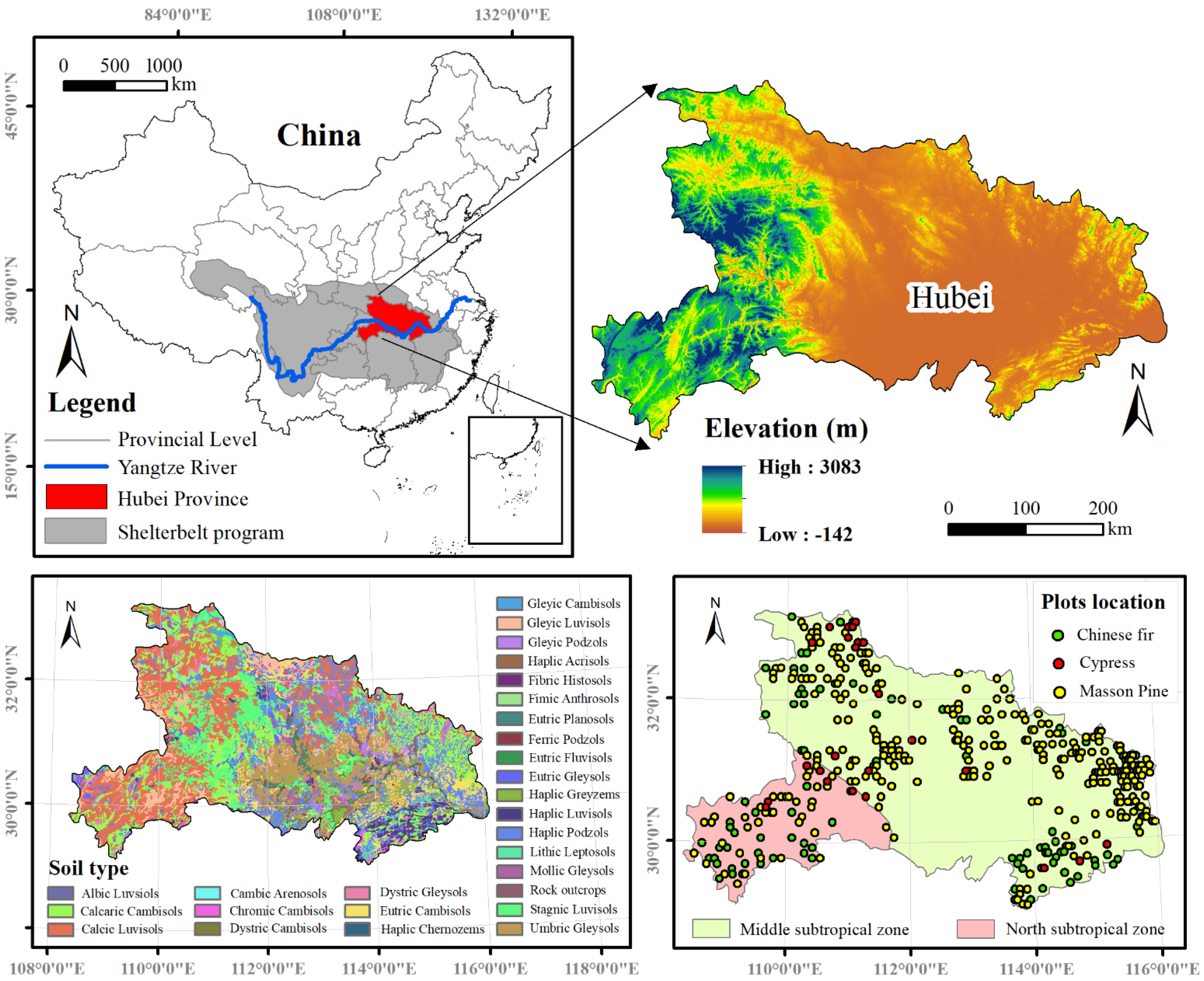

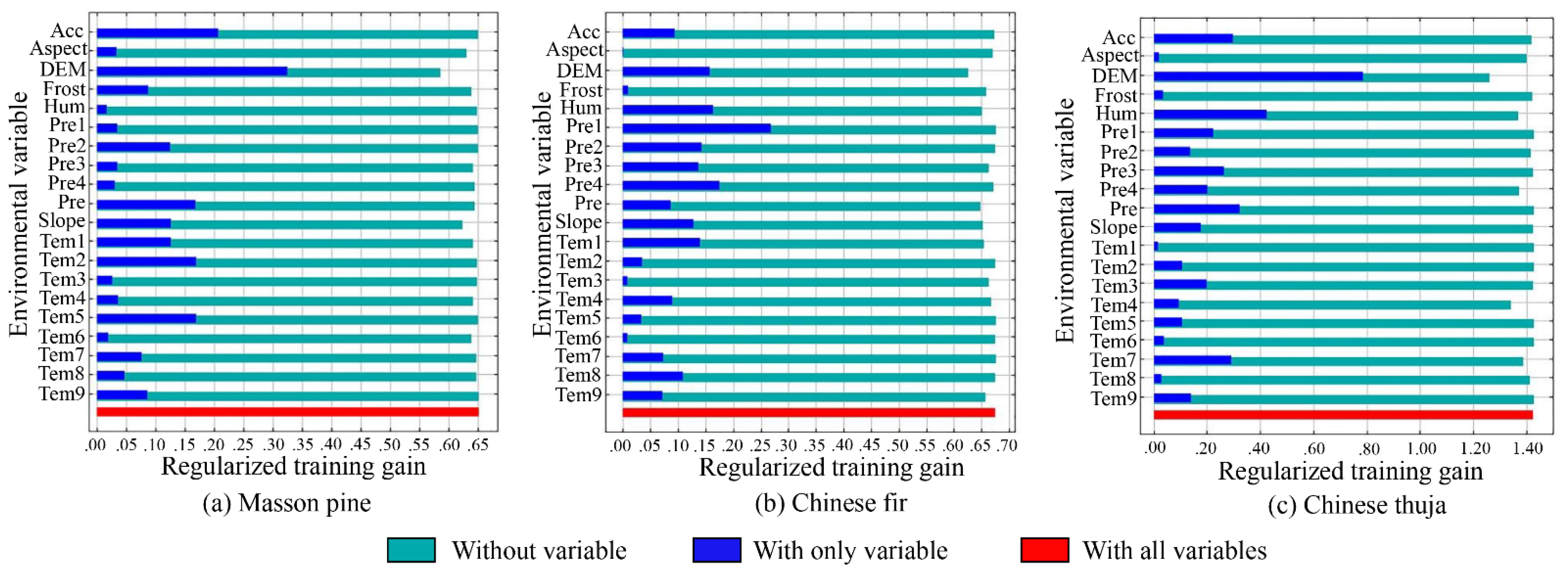


| Factors | Abbreviation | Content |
|---|---|---|
| Moisture factors | Pre1 | Annual precipitation |
| Pre2 | Precipitation of wettest quarter | |
| Pre3 | Precipitation of driest month | |
| Pre4 | Relative standard deviation of precipitation | |
| Heat factors | Acc | Accumulated temperature |
| Tem1 | Annual mean temperature | |
| Tem2 | Mean diurnal range | |
| Tem3 | Max temperature of warmest month | |
| Tem4 | Min temperature of coldest month | |
| Tem5 | Poor annual temperature | |
| Tem6 | Minimum daily temperature | |
| Tem7 | Temperature standard deviation | |
| Tem8 | Temperature annual range | |
| Tem9 | Isothermality | |
| Terrain factors | Dem | Digital elevation model |
| Aspect | Aspect | |
| Slope | Slope | |
| Other factors | Frost | Frost-free period |
| Pre | Air pressure | |
| Hum | Humidity | |
| ST | Soil type |
| Range of AUC Values | Evaluation Criterion | Range of AUC Values | Evaluation Criterion |
|---|---|---|---|
| 0.5 ≤ AUC < 0.6 | Failed | 0.8 ≤ AUC < 0.9 | Good |
| 0.6 ≤ AUC < 0.7 | Poor | 0.9 ≤ AUC < 1.0 | Excellent |
| 0.7 ≤ AUC < 0.8 | Mediocre |
| Environmental Factors | Main Coniferous Species | |||
|---|---|---|---|---|
| Masson Pine | Chinese Fir | Chinese Thuja | ||
| Moisture factors | Pre1 | 2.6 | 36.2 | 0.0 |
| Pre2 | 8.0 | 0.3 | 3.6 | |
| Pre3 | 3.8 | 3.0 | 0.1 | |
| Pre4 | 17.7 | 3.5 | 13.8 | |
| Total contribution | 32.1 | 43.0 | 17.5 | |
| Heat factors | Acc | 3.2 | 4.8 | 0.2 |
| Tem1 | 2.5 | 5.1 | 5.8 | |
| Tem2 | 1.0 | 0.0 | 0.0 | |
| Tem3 | 1.6 | 0.7 | 0.1 | |
| Tem4 | 2.1 | 1.5 | 14.5 | |
| Tem5 | 1.1 | 0.1 | 0.0 | |
| Tem6 | 0.5 | 0.0 | 0.0 | |
| Tem7 | 0.6 | 0.0 | 5.8 | |
| Tem8 | 0.2 | 0.0 | 0.5 | |
| Tem9 | 0.0 | 4.3 | 0.0 | |
| Total contribution | 12.8 | 16.5 | 26.9 | |
| Terrain factors | Dem | 38.1 | 10.7 | 36.1 |
| Aspect | 4.2 | 0.2 | 1.7 | |
| Slope | 10.1 | 13.8 | 0.1 | |
| Total contribution | 52.4 | 24.7 | 37.9 | |
| Other factors | Frost | 1.2 | 2.3 | 0.2 |
| Pressure | 1.3 | 5.0 | 0.0 | |
| Humidity | 0.1 | 8.6 | 17.6 | |
| Total contribution | 2.6 | 15.9 | 17.8 | |
| Types | Training Data AUC | Test Data AUC | Accuracy Evaluation |
|---|---|---|---|
| Masson pine | 0.828 | 0.767 | Good |
| Chinese fir | 0.856 | 0.745 | Good |
| Chinese thuja | 0.970 | 0.841 | Excellent |
Publisher’s Note: MDPI stays neutral with regard to jurisdictional claims in published maps and institutional affiliations. |
© 2022 by the authors. Licensee MDPI, Basel, Switzerland. This article is an open access article distributed under the terms and conditions of the Creative Commons Attribution (CC BY) license (https://creativecommons.org/licenses/by/4.0/).
Share and Cite
Yi, Y.; Shi, M.; Liu, J.; Zhang, C.; Yi, X.; Li, S.; Chen, C.; Lin, L. Spatial Distribution of Precise Suitability of Plantation: A Case Study of Main Coniferous Forests in Hubei Province, China. Land 2022, 11, 690. https://doi.org/10.3390/land11050690
Yi Y, Shi M, Liu J, Zhang C, Yi X, Li S, Chen C, Lin L. Spatial Distribution of Precise Suitability of Plantation: A Case Study of Main Coniferous Forests in Hubei Province, China. Land. 2022; 11(5):690. https://doi.org/10.3390/land11050690
Chicago/Turabian StyleYi, Yang, Mingchang Shi, Jialin Liu, Chen Zhang, Xiaoding Yi, Sha Li, Chunyang Chen, and Liangzhao Lin. 2022. "Spatial Distribution of Precise Suitability of Plantation: A Case Study of Main Coniferous Forests in Hubei Province, China" Land 11, no. 5: 690. https://doi.org/10.3390/land11050690
APA StyleYi, Y., Shi, M., Liu, J., Zhang, C., Yi, X., Li, S., Chen, C., & Lin, L. (2022). Spatial Distribution of Precise Suitability of Plantation: A Case Study of Main Coniferous Forests in Hubei Province, China. Land, 11(5), 690. https://doi.org/10.3390/land11050690






